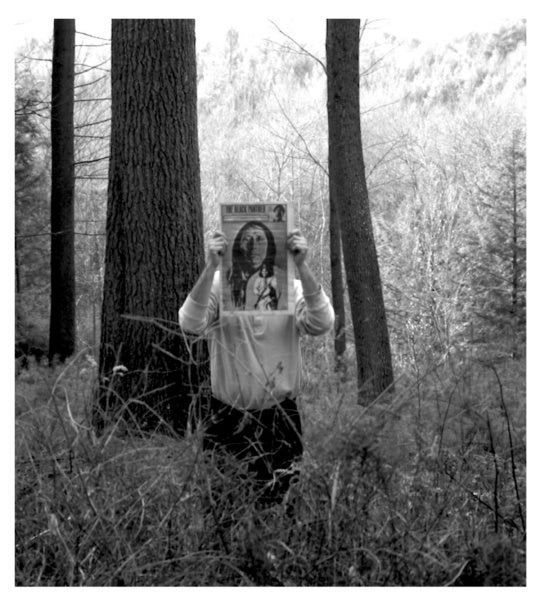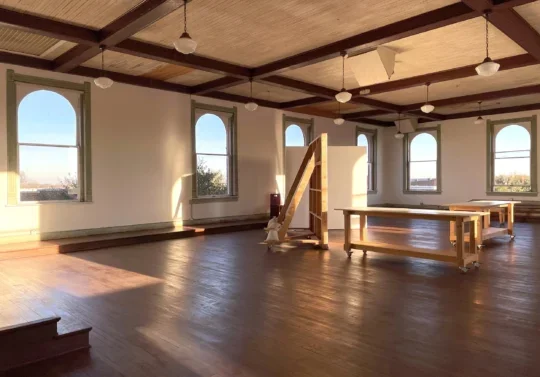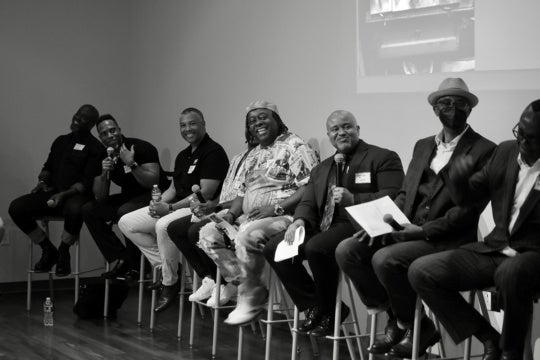
Since Gallery Protocol’s inception, Chase Westfall’s programming has made the space a cultural center in Gainesville. The gallery is enriched by well-curated exhibitions, a residency program for emerging artists, studio spaces, a commercial event space, and an adjacent cafe. The latter is where I met Peter Gouge, a young New Zealand-born painter whose show “A Trip to ___” was on view January 29-March 3. His paintings are charming and self-effacing, much like the artist himself. Due to our lack of foresight, we sat outside the closed gallery while we discussed his practice, the current exhibition, and his horrible taste in movies.
Gouge (b. Auckland, 1984) is currently based in Gainesville, Florida. He has a Bachelor of Design from Unitec, Auckland (2009). In 2014, he was featured in Art Collector magazine (Australia) as an emerging artist to watch.
Proud standard bearers of the Formalist tradition, Gouge’s works are self-aware without being self-conscious, allowing them to move and cite freely within the history of painting without falling prey to the idealism or anti-idealism of Modernism and Postmodernism respectively.
―from the exhibition statement by Chase Westfall

Peter Gouge: You know that saying: being an artist is like being a shark — if you stop moving you die?
Budd Dees: But aren’t sharks like the least evolved species?
PG: I think so, yeah. Apart from one lizard in New Zealand called the Tuatara, which is apparently older than the shark.
BD: Did you read the statement that Chase wrote? I think your paintings are firmly in his wheelhouse. If I had your paintings and someone asked me about them, I wouldn’t know where to start, but if you could just recall that statement, in an elevator pitch format, you’d be pretty good.
PG: Yeah, I was extremely happy with it. And I didn’t have to talk to him about any of that stuff. It is really nice when someone just gets it, you know? And can then put it into words more eloquently than I could myself.
BD: I went to your site and there was no statement.
PG: I don’t know, I mean, I guess back home the people’s websites that I look at don’t have artist statements. That’s something that I’ve come across here. We’re generally a very quiet people. [laughs]
BD: Are there any other big differences? To me your paintings feel like they fit in well here in the States. Like, if we feed off of New York …
PG: I think that’s the same for people in New Zealand. We do have our own specific circumstances. There’s the term “cultural cringe,” meaning anything local is automatically not as good as anything going on globally, which generally is like New York, L.A., London. I think it probably works just as well in a town like this.

BD: So, it’s like the opposite of fetishized regionalism?
PG: Yeah! It could go either way. Some people are making excellent work because it’s heretically not what’s going on in the big cities. For my own work, though, I think the Internet’s gone a long way to making all that really accessible. It’s just like fashion and everything else. It seems like it’s going to be impossible for regional fashions to go on.
BD: Is there any scrap of New Zealand that remains in your paintings?
PG: You know, I’m not sure, because I’m not sure that I could really boil what New Zealand is down to forms. I don’t know, the art school I went to, a lot of us came out making paintings that were a lot to do with patterns and decorations, that kind of stuff. That’s quite specific to that particular school.
BD: Did you ever paint in a more realistic style?
PG: Yeah, as an undergrad I painted figuratively, like realistically; abstraction kind of freed everything up. That was a relief from the pressures of realism and skill. [laughs]
BD: Well, I really like your show. How do you decide how to arrange your pieces on the wall?
PG: I’m really happy with the way it all turned out. Chase and I did that in an afternoon. It’s handy to have someone who knows the space and the way that people move through it. Kind of eyeline stuff, I guess, in some places, but mostly intuition. I generally don’t like it when it’s a line of paintings. I like having them in pairs, like beats, so there is a rhythm to the way people experience the work.
BD: Can you tell me about your titles?
PG: Basically, the titles don’t mean much to me. I think of the paintings as being made of units. In the construction of the painting, there’s basically four or five elements. There’s the background and the pipe kind of things. So there’s a whole lot of standardized things. And that’s with the grid paintings as well, and even the carpet paintings. They’re basically all made very similarly. There are units of a 1-inch brush, a 2-inch brush, a 3-inch brush, so it’s kind of this reductive idea. The titles just echo that and the acronyms can be made to mean anything.

BD: On opening night, you said that the titles are abbreviated song titles, but that you forgot what songs they referenced, which I thought was really funny, because you could say that the forms were in reference to something but the referent is no longer important.
PG: That is a simpler answer, definitely. [laughs]
BD: Do these “units” of your paintings come from something? Do they just come from the tools that you use?
PG: Essentially. There’s all these options available, so you can make anything. So for me, the thing to do was to reduce the amount of options. Like, I’m going to use the grid, and what can I do within the grid? It’s trying to reduce options to open up some other kind of space. Like the carpet paintings, you can’t really paint very well on this carpet. It’s horrible.
BD: And disgusting … so congrats? It’s the grossest. Well, I’m sure I’ve seen a grosser painting but I can’t recall. I think artists have a thing with carpet. Were those satisfyingly grotesque?
PG: It is, yeah. It’s like well there’s not much I can do with this so, fuck it, let’s just put some lines down!
BD: Do you watch TV when you paint?
PG: Yeah, I do. Especially when making the grid paintings because they’re very time-consuming.
BD: So you make a plan and you just have to execute?
PG: Pretty much. Like with the grid paintings, basically I’ll have a tube color and five tints going down to white, and as much as possible I’ll try to make some gradients or something like that. So, I premix the colors and everything is planned. Of course, things change in the making of the work, but that’s painting. I do plan pretty much everything. Even the carpet works. I always have some idea of where things are going to go.
BD: What do you watch?
PG: I generally watch a lot of really terrible movies. Recently, I went through a patch of watching really, really bad stuff. I got to Joe Dirt 2…
BD: Okay, it’s worse than I could have imagined, honestly. I thought you were gonna say a dumb campy or blockbuster, but that is the bottom of the barrel.
PG: It’s just background noise.

a detail of K.I.T.H.B.A.H.
BD: I saw an image on your Instagram of a close-up. It felt like you were delighting in this thick layer of paint.
PG: The nice thing about paint is that it’s really physical. That was actually encaustic, wax mixed with pigment. That’s generally what I like about that stuff. It is what it is.
BD: Have you ever seen Bad Girls Club? It’s a show where terrible women are given alcohol and they just fight. And something they say to end a fight is, “It is what it is,” which is so related to phenomenology. That’s Minimalism.
PG: I think I’ve seen GIFs of this.
BD: What’s a bad painting for you?
PG: In the Mapplethorpe case, one of the lawyers or somebody said something along the lines of the difference between pornography and art is you know it when you see it. If I keep a painting that I think is bad, six months later, it’s good. Sometimes, that difficulty is something that I really look for, but I do find it hard to know at the time. Generally, I’ll work on a bunch of things at once, and if something’s troubling me I’ll just leave it for a little bit.

T.T.F.R.A.R., 2016; oil, enamel and spray paint on carpet, 16 by 20 inches.
BD: Can you talk about why you don’t paint on canvas?
PG: The grid paintings are on burlap. It’s not wildly different from canvas. It’s just a little bit hairier. I started making work on burlap and I really liked the rougher surface. I was going through post-grad back home. You have to push things further and further and further. So what’s the most horrible thing I could think of painting on? I tried a few things but carpet definitely was the worst.
BD: What was between burlap and carpet?
PG: It was burlap, then I tried towels. They were sort of horrible. The thing with the carpet is that you can have it free-hanging and that’s a really different thing. Towels you still have to stretch around something. I tried plastic matting as well. Carpet works on its own; it doesn’t have to be stretched.
BD: It’s a very punishing practice you have, in that you plan things out, you remove a lot of the fun things that I loved about painting when I was a young painter.
PG: A lot of traditionally pleasurable parts of painting I find horribly, horribly anxiety-inducing. Like de Kooning. I love de Kooning but shit, it horrifies me. I’m so terrified that I’m going to fuck it up that I never start. I think there’s a degree of removal that I need.
BD: So even if it is a grueling six-hour workday while you watch Joe Dirt 2, at least you know what to do? Okay, that explains some things.
PG: Yes!
BD: So would you mind defending your entire field? Have you ever been asked by a more socially engaged artist, “But what does it do?”
PG: I feel like I’ve spiritually had that kind of question. I guess it’s a valid question, but it’s one that’s almost impossible to answer with any degree of … generally, painting … it’s a frivolous kind of thing. If you look at it as decoration, it’s really frivolous. If you look at it as an activist, painting generally doesn’t work that well as a way to change anything. There’s maybe a couple of paintings, like Guernica. That’s kind of it, you know? In those senses, it does fail; but I think that’s fine.

BD: It’s a totally unfair question, I’m sorry. [laughs] Your entire practice is sort of about refusal, you call it “reductive.” And even the way that you title is super unpleasurable, in a way. You know it’s not satisfying; there’s no sentimental, no social, no political.
PG: I feel like the only sentimental part of it is the fact that they are from song titles.
BD: Yeah, but that’s just a tease.
PG: Because, to me, it’s basically just that calling everything “Untitled” is a bit of a cop-out. When I was talking about the art school that I went to, patterns and decorations were touchstone for that kind of painting. Like those same questions can be asked of decorative art. What does it do? And the answer is well, it’s pleasurable, it’s nice to look at, it’s nice to think about. That’s kind of it.
BD: But yours is not pleasurable. I mean, I guess your colors are vibrant, but the process purges all pleasure other than the color.
PG: I think that Chase nailed something in this idea of oscillating between these two boundaries, courting pleasure and not.
BD: Even the way you cut your panels … it’s like so close to being satisfying, but it’s not quite. It doesn’t quite break the rectangle enough to rebel against the rectangle but it’s like 10% there. So, wherever you are positioned in relation to painting, your work is not satisfying. If you are a traditional painter, you’re not satisfied; if you are a rebel artist, you aren’t satisfied either.
PG: It’s always interesting to think about this kind of stuff, where I’m positioned and all that. I always talk about the work being halfway between some of the ideas of Minimalism and halfway between some of the ideas of action painting. It’s this really uncomfortable sort of middle ground where neither thing is satisfied, but maybe that’s a good way to push off to the future.
Budd Dees is a maker working in real and virtual spaces as a sculptor, writer, and digital artist. He lives and works in Gainesville, Florida, where he teaches and creates. He loves cats, distrusts experts, and sings the boy parts on the B-52s “Song for a Future Generation.” He really does want to be “the nicest guy on Earth.”




